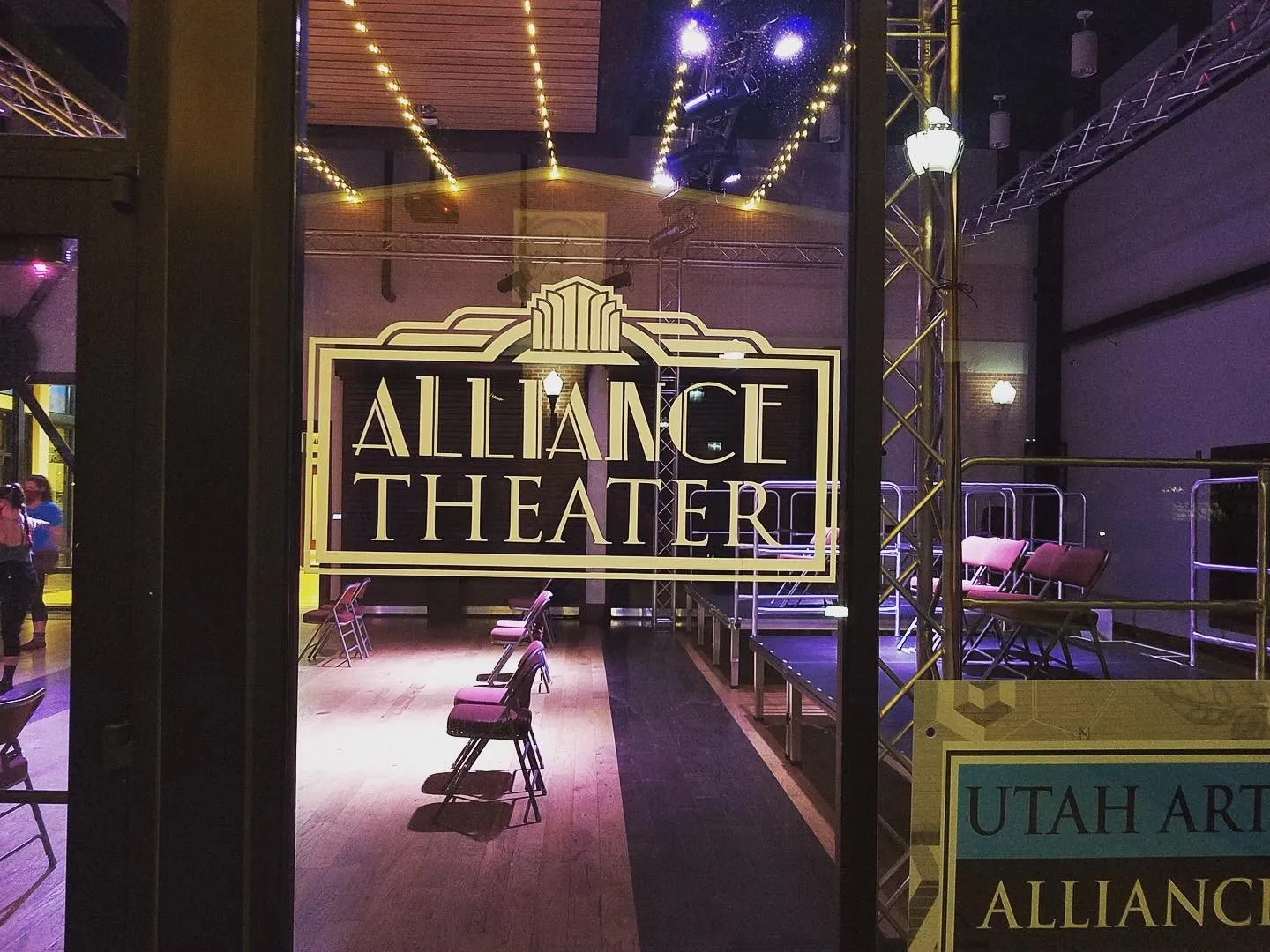
Play Reviews: The 10th Annual Great Salt Lake Fringe
Performance & Theatre
Since its first edition in August 2015, the annual Great Salt Lake Fringe has showcased original and uncensored productions of theater, dance, storytelling and music. This year’s festival, hosted at the Alliance Theater in Trolley Square from July 26–August 4, includes 20 shows ranging from absurdist comedy and interactive karaoke to long-form improv and avante-garde burlesque. SLUG Contributing Writers Aspen English and Lina Boyer reviewed six premieres during the first weekend to give you a taste of what the Fringe has to offer. Explore even more shows and purchase tickets for the second weekend at greatsaltlakefringe.org!
The Funeral Potatehoes!!!
In case you’re not familiar with the local delicacy, funeral potatoes are a classic Mormon dish best served piping hot from your local Relief Society President. They’re unassuming at first, but incredible once you dig in—and this group of brand-new drag artists are the same. As anyone who grew up Mormon could tell you (especially any queer or gender non-conforming folks), the experience lends itself to a niche subtext of media, proclivities and stereotypes. Described by the creators as “moments that made me question everything,” The Funeral Potatehoes!!! is an antithetical homage to that experience.
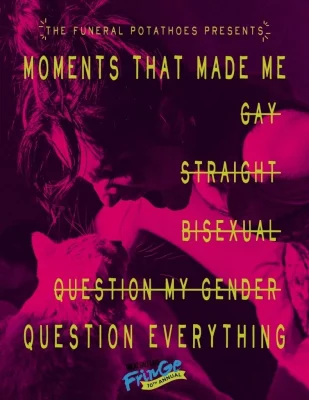
In fact, to call it just a show would be a massive understatement. In their world premiere, sisters “Loaded” (Anna Chapman) and “Baked” (Laura Elise Chapman) put on a full-scale performance. The props? Handmade. The references? Niche and hilarious. The vocals? Entirely live (with the exception of a lip-synced, sapphic Toy Story bit). I won’t spoil it for you, but let’s just say that it starts with a pantsless Hozier in fishnets, which later turns into Jesus. The montage-style storyline jumps from topic to topic with incredible effortlessness—as soon as you think it might be getting serious, the punchline hits.
In the span of 60 minutes, you’ll get to live the experience of growing up queer within Utah’s infamously predominant religion. If your sexual awakening was Joseph and the Technicolor Dreamcoat, Twilight or Carol Burnett in the 1982 film adaptation of Annie, this performance is for you. In a type of intimate chaos normally reserved for your best friend’s bedroom at 2 a.m., Loaded and Baked delivers odes to a sexually repressed childhood, head-back-laughter–worthy quips and poignant commentary on the frivolity of gender. Check out the last showing of this borderline spiritual experience on Saturday, August 3 at 4:30 p.m. Miss it at your own risk. –Aspen English
Hark!
Hark!, the original one-act written by Salt Lake City playwright AB Harrison, begs the age-old question: What if a marooned sea captain from the 17th century was trapped on a purgatorial island with a corporate girlboss from the 1980s?
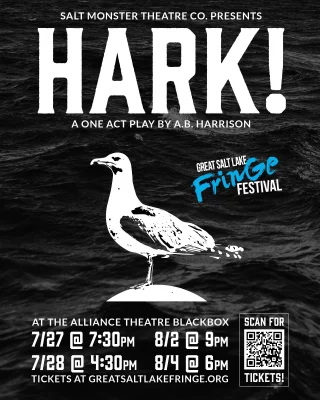
This play is like Waiting for Godot, if Waiting for Godot was a slapstick comedy involving a loud and impassioned pirate. Most of the plot lies in how these two characters, Longbeard (Percy Cordero) and The Maiden (Griz Siebeneck), pass the time when stuck in between life and death for eternity. While the two aren’t exactly friends, they share a certain camaraderie as two people who only have each other. It’s certainly an interesting pairing, and one I haven’t seen before. While Longbeard sings loud sea shanties and laments about his wife and daughter, The Maiden tells him to shut up and laments about the traffic she’s missing. Siebeneck does a truly impressive job of transforming from a no-nonsense, blouse-wearing professional to a starved animal in 0.2 seconds, while Cordero manages to maintain a very heightened level of emotion throughout the entirety of the story. In addition to this odd couple, there are also a handful of sea creatures portrayed by puppeteer Rachael Pace. These little wooden critters are captivating and highly entertaining, without taking away from the human characters. And honestly, who doesn’t love a puppet?
At times, it felt like there was chaos simply for the sake of chaos and pieces of the story got lost in the confusion, but between the shouting and kraken fighting, there were moments of real tenderness between these ill-fated souls. It may be an absurd situation, but it does provide an excellent source to reflect on what human connection really is. Hark! runs again on Friday, August 2 at 9:00 p.m. and Sunday, August 4 at 6:00 p.m. –Lina Boyer
How Did We Get Here?
In the world of stand-up, every comedian needs some trauma to joke about, right? During How Did We Get Here? the audience got a taste of the experiences that gave four local comedians something to crack jokes about. As first act Spencer Riley explains it, the show is “essentially a bunch of comics telling stories about their lives.” And so he did—Riley shared details about his first-ever gig at age 19, facing down a crowd of Proud Boys. It was an amusing set, marked by wry self-awareness and a compelling narrative.
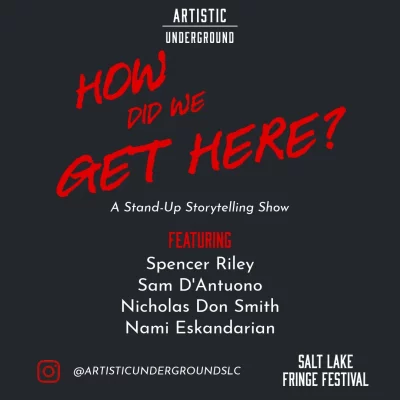
Next up was Nami Eskandarian, with his own interpretation of the show’s theme: a PowerPoint presentation on the Japanese media franchise Tekken. While Tekken’s lore is, I’ll admit, quite humorous, I spent Eskandarian’s set wishing for a shred of relevance to the overall theme. After all, most of the Tekken content revolved around daddy issues—there’s got to be some opportunity for personal commentary there.
By the time we got to Sam D’Antuono, I had nearly forgotten the point of the show, but
D’Antuono got us back on track nicely by sharing that his girlfriend cheated on him, and only professional wrestling is getting him through it. While his deadpan delivery suited the material, the bitter undertone sometimes made it hard to tell if laughter was the right response.
The show concluded with Nicholas Don Smith, who took to the stage with a notebook and an iced coffee, warning the audience that he might cry. Spoiler alert: He did, mid-“Lord of the Rings” quote. His set centered around his late mother’s battle with Alzheimer’s, but the punchlines often got lost in the emotional setup. Maybe How Did We Get Here? lived up to its name after all, because by the end of the show I was asking myself that exact question. They say that art is supposed to comfort the disturbed and disturb the comfortable… well, perhaps I’m just not disturbed enough. Catch How Did We Get Here? on Saturday, August 3 and Sunday, August 4 at 1:30 and 3:30 p.m. to experience it for yourself. –Aspen English
I’ve Decided to Become a Digital Pet
I’ve Decided to Become a Digital Pet is, surprisingly, about exactly what you might think it is—the desire to upload your consciousness and (literally) become a digital pet.
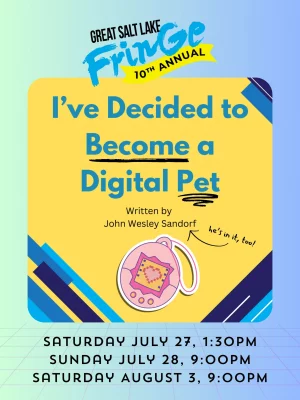
In this short, one-man show, John Sandorf explores his own lonely childhood, and with it, his connection (or obsession) with the Tamagotchi, a Japanese toy that allows you to keep and care for a digital pet. Rather than tell you his life story, Sandorf takes you on a journey to experience it alongside him. Using various toys to portray the other people in his life, core childhood memories come to life in the same way I remember playing pretend as a child—toys are animated by Sandorf’s hand, and as soon as their piece is played out in the story, they are dropped unceremoniously onto the floor. By the end, they become a sort of colorful, plush graveyard of all the experiences that brought him to his ultimate decision to leave reality behind.
While this one-act deals with very real and somber issues—bullying, depression, the feeling of not quite fitting in—Sandorf strikes a great balance between solemn and hilarious. Even at its most heartbreaking moments, I still found myself laughing. Sandorf is a witty writer and an incredibly endearing storyteller, with the ability to create a beautifully awkward connection with the audience. It is fully worth the fifteen minutes and more. I’ve Decided to Become a Digital Pet, written, directed and performed by Sandorf (with special guidance from Danna Facer), runs again on Saturday, August 3 at 9:00 p.m. –Lina Boyer
The Post Office
Before the play even begins, the audience is met with a visually vibrant set. Colorful fabrics are draped over clothing lines, beautiful rugs decorate the floor and paper-covered boxes frame the stage. While it’s all a little messy, it comes together cohesively to form a street scene, where doors and windows can be made of anything and convincingly shift open or closed by the movement of a box.
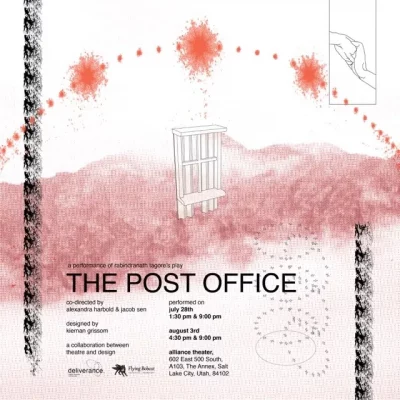
Originally written in Bengali by playwright Rabindranath Tagore in 1912, this adaptation of The Post Office is a collaborative effort, co-directed by Jacob Sen and theater maker/professor Alexandra Harbold. Set in rural Bengal, it follows a young boy named Amal (Sen). After falling ill, his uncle/adoptive father (Hans Fenton) tells the boy he must stay inside, per the advice of the family’s physician (Jordan Palmer). While Amal technically obeys this, he manages to befriend practically the entire town from his windowsill. In the process he learns (and dreams) about the world beyond his room.
The world of this play is beautifully fleshed out, and Sen is undeniably likable as young Amal. Scene transitions flow together so fast it often feels like they’re happening at the same time—the lines between what is occurring in real life and what is occurring in Amal’s imagination blur together, but it never feels necessary to know for certain what’s real and what’s not. This play reads as both a slice of life and an epic wrapped into one—while playful and tender, it is far from lacking in depth. Certain members of the audience, who shall remain unnamed (me), were left tearing up long after the play ended. If you, too, would like to feel these emotions, it runs again on Saturday, August 3 at 4:30 and 9:00 p.m. –Lina Boyer
Western Minerals and Their Origins
If you’ve ever spent time in the desert of southern Utah, you may be familiar with a very particular type of solitude—something that’s difficult to describe in words. Whatever this feeling is, Western Minerals and their Origins manages to capture it perfectly.
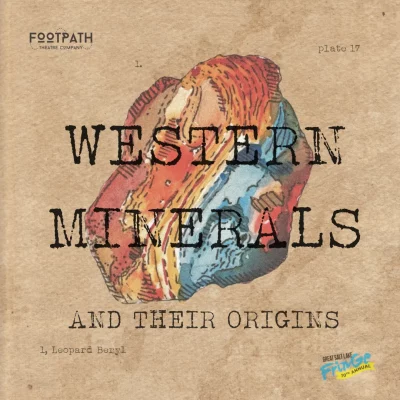 Written, directed and performed by Footpath Theatre Company trio Jessica Graham, Connor Johnson and Harrison Lind, this is a truly unique and, as advertised, psychedelic story. After discovering an old notebook hidden within an even older textbook, Ari (Graham) follows the words of distinguished geology professor William K. Wagley (Johnson) and explorer Leo Spalding (Lind) on a journey to find a rare rock in the desolate Cadaver Canyon. What follows is nothing short of magical—a story where reality and imagination blend together, and the past and present exist simultaneously.
Written, directed and performed by Footpath Theatre Company trio Jessica Graham, Connor Johnson and Harrison Lind, this is a truly unique and, as advertised, psychedelic story. After discovering an old notebook hidden within an even older textbook, Ari (Graham) follows the words of distinguished geology professor William K. Wagley (Johnson) and explorer Leo Spalding (Lind) on a journey to find a rare rock in the desolate Cadaver Canyon. What follows is nothing short of magical—a story where reality and imagination blend together, and the past and present exist simultaneously.
This is a stunning cast—the actors play three very distinct characters, which seemingly exist in different times and realities, but they blend together in this story seamlessly. Each of them play into a familiar archetype without ever falling into a caricature.
While the set is bare, it never feels that way; minimal set pieces transform into towering sandstone cliffs, a rocky canyon floor and even a sweeping flash flood. But perhaps most spectacular is the live electronic score, composed by Lind and performed on stage with local musician Max Bastiani. Not only does the sound help set the scene of a quiet, isolated desert, but it transforms into a character of its own on multiple occasions. At one point it is a kangaroo mouse, at another point a conscious rock and, in a climactic moment, the soundscape becomes the passage of time itself. If you’ve ever wanted to experience history from a desert’s perspective (haven’t we all?), this is the show to see. It runs for one more weekend on Saturday, August 3 at 6:00 p.m. and Sunday, August 4 at 3:00 p.m. –Lina Boyer
Read more play reviews:
Play Review: Bitter Lemon
Play Review: Murder on the Orient Express
